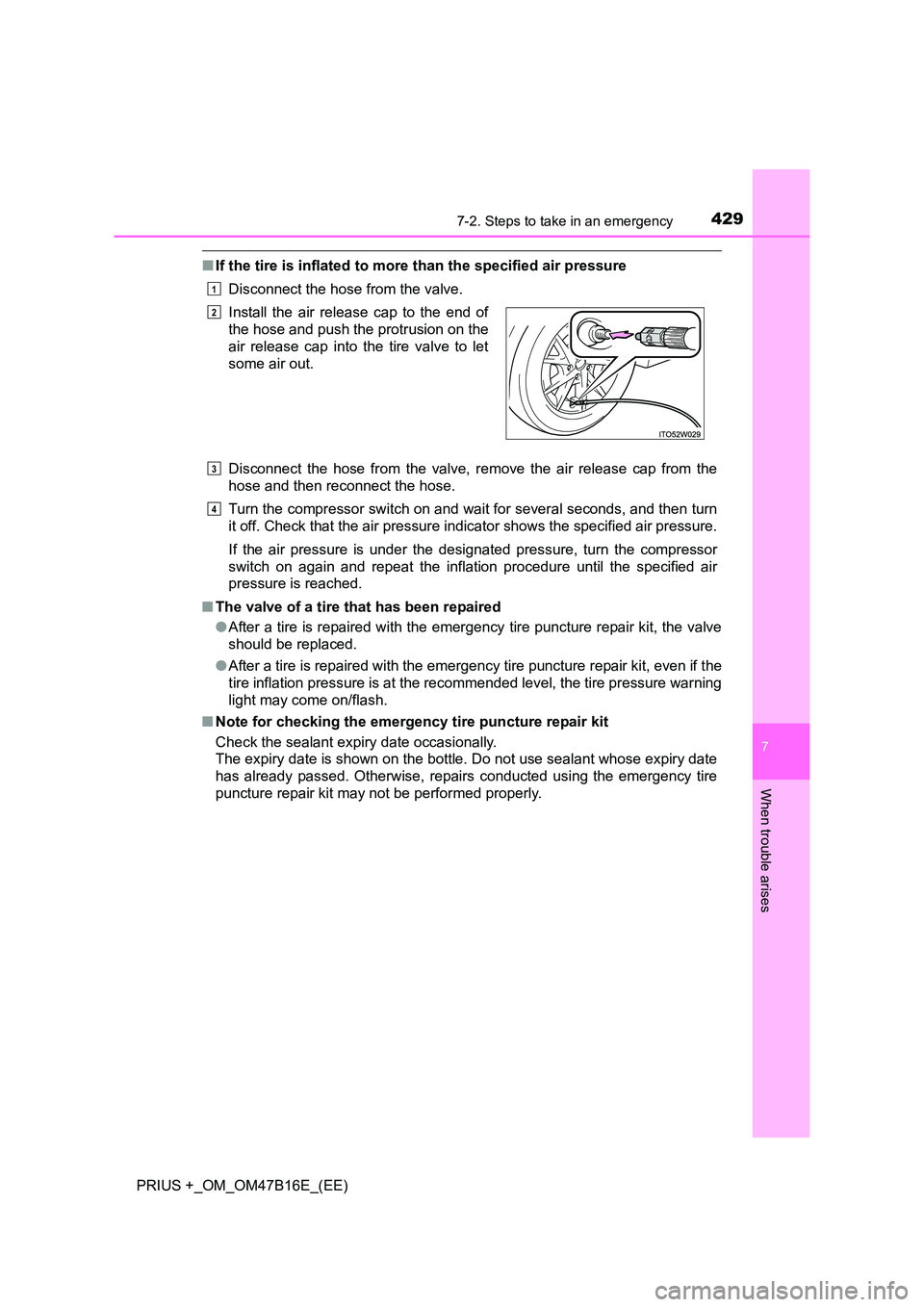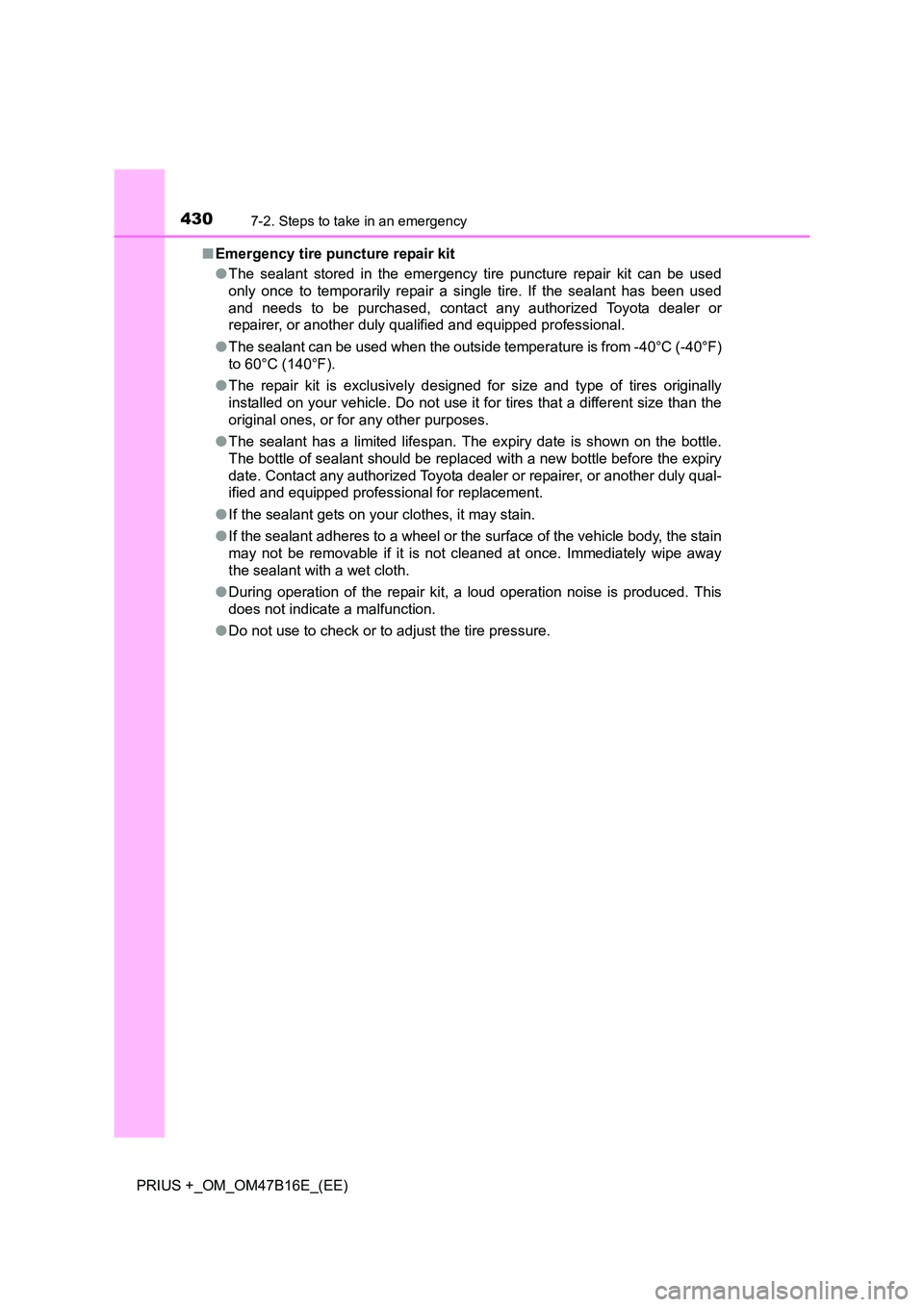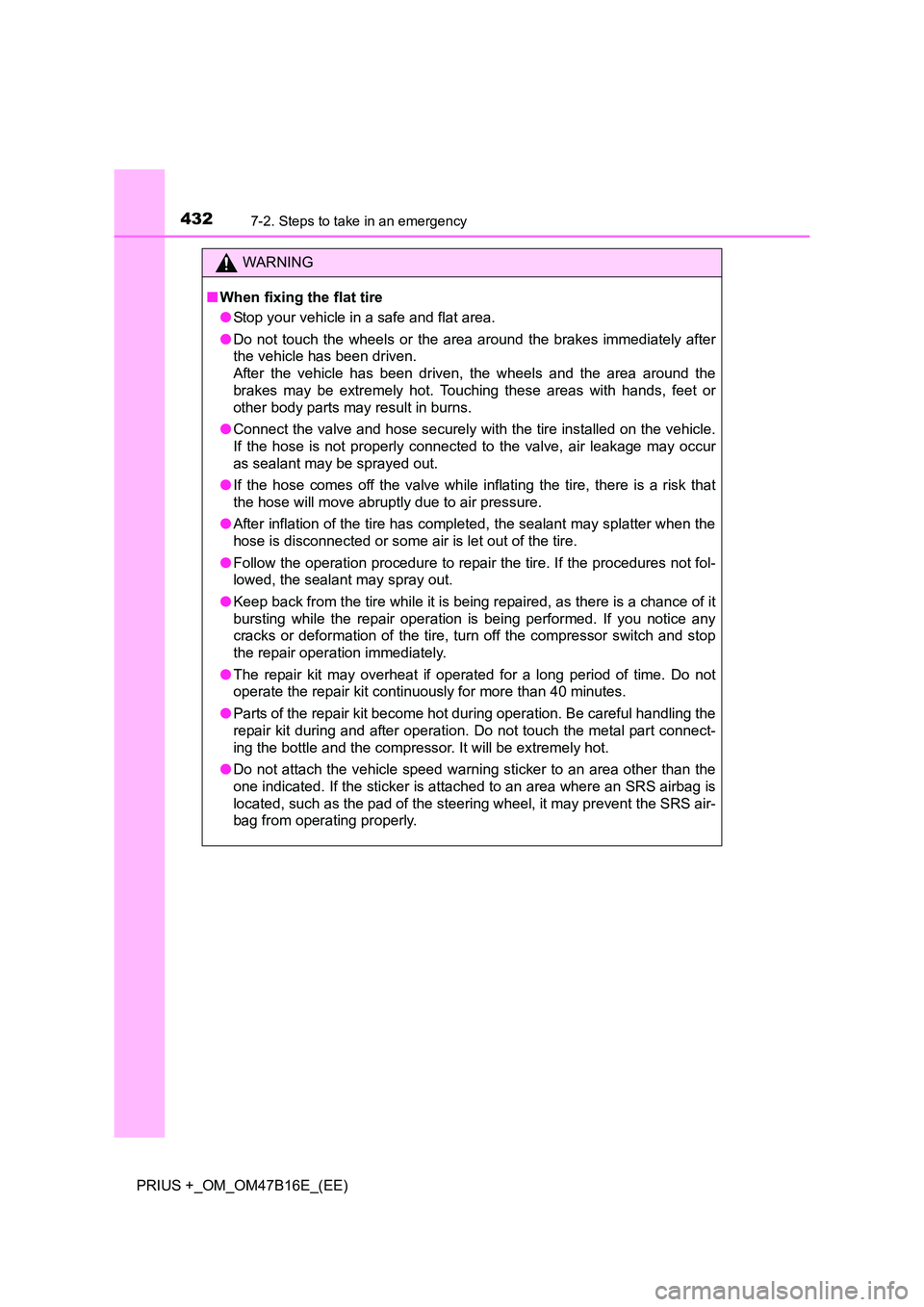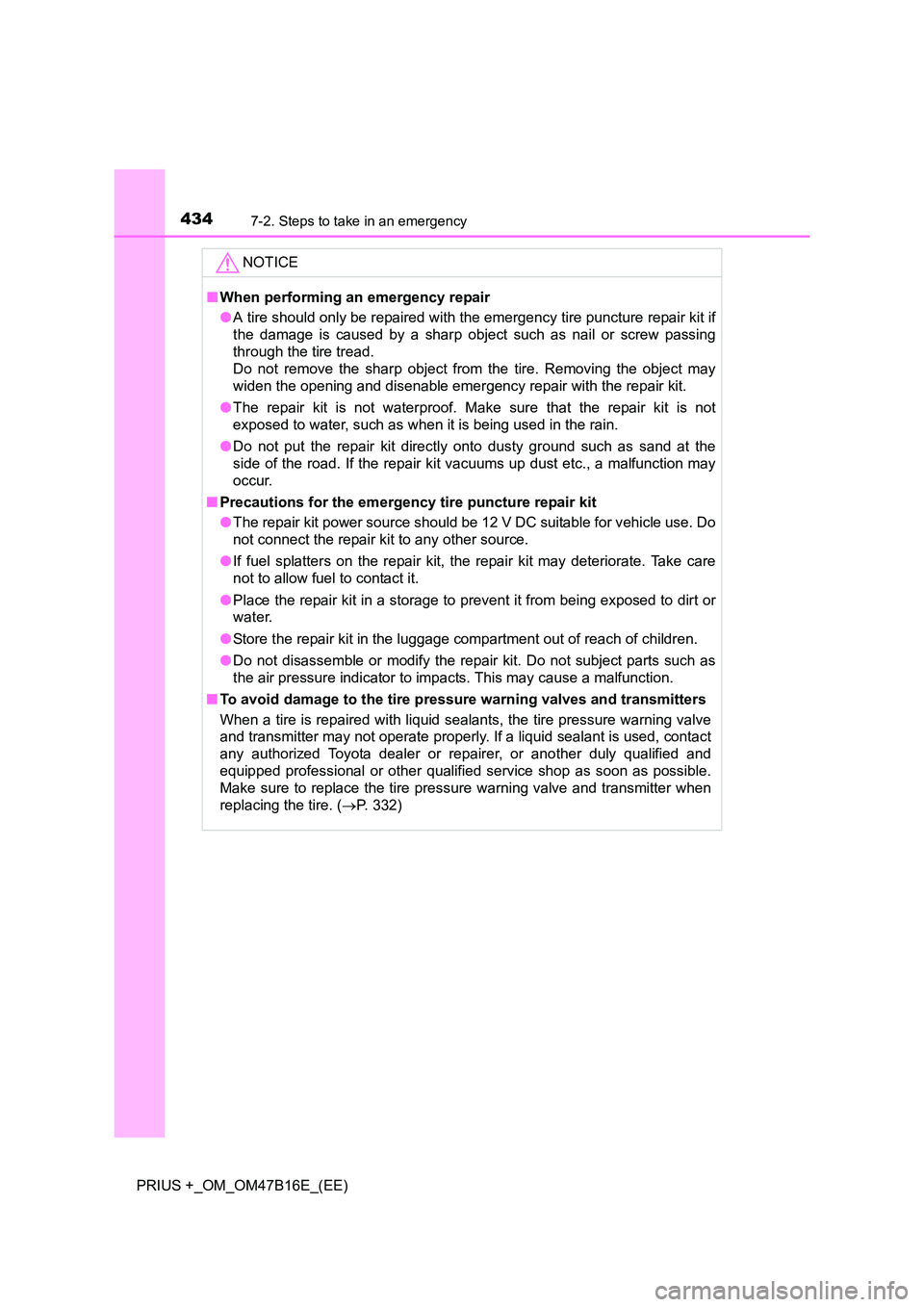Page 429 of 496

4297-2. Steps to take in an emergency
PRIUS +_OM_OM47B16E_(EE)
7
When trouble arises
■If the tire is inflated to mo re than the specified air pressure
Disconnect the hose from the valve.
Disconnect the hose from the valve, remove the air release cap from the
hose and then reconnect the hose.
Turn the compressor switch on and wait for several seconds, and then turn
it off. Check that the air pressure indicator shows the specified air pressure.
If the air pressure is under the designated pressure, turn the compressor
switch on again and repeat the inflation procedure until the specified air
pressure is reached.
■ The valve of a tire that has been repaired
●After a tire is repaired with the emergency tire puncture repair kit, the valve
should be replaced.
● After a tire is repaired with the emergency tire puncture repair kit, even if the
tire inflation pressure is at the recommended level, the tire pressure warning
light may come on/flash.
■ Note for checking the emergency tire puncture repair kit
Check the sealant expiry date occasionally.
The expiry date is shown on the bottle. Do not use sealant whose expiry date
has already passed. Otherwise, repairs conducted using the emergency tire
puncture repair kit may not be performed properly.Install the air release cap to the end of
the hose and push the protrusion on the
air release cap into the tire valve to let
some air out.
1
2
3
4
Page 430 of 496

4307-2. Steps to take in an emergency
PRIUS +_OM_OM47B16E_(EE)■
Emergency tire puncture repair kit
●The sealant stored in the emergency tire puncture repair kit can be used
only once to temporarily repair a single tire. If the sealant has been used
and needs to be purchased, contact any authorized Toyota dealer or
repairer, or another duly qualified and equipped professional.
● The sealant can be used when the outside temperature is from -40°C (-40°F)
to 60°C (140°F).
● The repair kit is exclusively designed for size and type of tires originally
installed on your vehicle. Do not use it for tires that a different size than the
original ones, or for any other purposes.
● The sealant has a limited lifespan. The expiry date is shown on the bottle.
The bottle of sealant should be replaced with a new bottle before the expiry
date. Contact any authorized Toyota dealer or repairer, or another duly qual-
ified and equipped professional for replacement.
● If the sealant gets on your clothes, it may stain.
● If the sealant adheres to a wheel or the surface of the vehicle body, the stain
may not be removable if it is not cleaned at once. Immediately wipe away
the sealant with a wet cloth.
● During operation of the repair kit, a loud operation noise is produced. This
does not indicate a malfunction.
● Do not use to check or to adjust the tire pressure.
Page 432 of 496

4327-2. Steps to take in an emergency
PRIUS +_OM_OM47B16E_(EE)
WARNING
■ When fixing the flat tire
●Stop your vehicle in a safe and flat area.
● Do not touch the wheels or the area around the brakes immediately after
the vehicle has been driven.
After the vehicle has been driven, the wheels and the area around the
brakes may be extremely hot. Touching these areas with hands, feet or
other body parts may result in burns.
● Connect the valve and hose securely with the tire installed on the vehicle.
If the hose is not properly connected to the valve, air leakage may occur
as sealant may be sprayed out.
● If the hose comes off the valve while inflating the tire, there is a risk that
the hose will move abruptly due to air pressure.
● After inflation of the tire has completed, the sealant may splatter when the
hose is disconnected or some air is let out of the tire.
● Follow the operation procedure to repair the tire. If the procedures not fol-
lowed, the sealant may spray out.
● Keep back from the tire while it is being repaired, as there is a chance of it
bursting while the repair operation is being performed. If you notice any
cracks or deformation of the tire, turn off the compressor switch and stop
the repair operation immediately.
● The repair kit may overheat if operated for a long period of time. Do not
operate the repair kit continuously for more than 40 minutes.
● Parts of the repair kit become hot during operation. Be careful handling the
repair kit during and after operation. Do not touch the metal part connect-
ing the bottle and the compressor. It will be extremely hot.
● Do not attach the vehicle speed warning sticker to an area other than the
one indicated. If the sticker is attached to an area where an SRS airbag is
located, such as the pad of the steering wheel, it may prevent the SRS air-
bag from operating properly.
Page 433 of 496
4337-2. Steps to take in an emergency
PRIUS +_OM_OM47B16E_(EE)
7
When trouble arises
WARNING
■ Driving to spread the liquid sealant evenly
Observe the following precautions to reduce the risk of accidents.
Failing to do so may result in a loss of vehicle control and cause death or
serious injury.
●Drive the vehicle carefully at a low speed. Be especially careful when turn-
ing and cornering.
● If the vehicle does not drive straight or you feel a pull through the steering
wheel, stop the vehicle and check the following.
• Tire condition. The tire may have separated from the wheel.
• Tire inflation pressure. If the tire inflation pressure is 130 kPa (1.3 kgf/
cm
2 or bar, 19 psi) or less, the tire may be severely damaged.
Page 434 of 496

4347-2. Steps to take in an emergency
PRIUS +_OM_OM47B16E_(EE)NOTICE
■
When performing an emergency repair
●A tire should only be repaired with the emergency tire puncture repair kit if
the damage is caused by a sharp object such as nail or screw passing
through the tire tread.
Do not remove the sharp object from the tire. Removing the object may
widen the opening and disenable emergency repair with the repair kit.
● The repair kit is not waterproof. Make sure that the repair kit is not
exposed to water, such as when it is being used in the rain.
● Do not put the repair kit directly onto dusty ground such as sand at the
side of the road. If the repair kit vacuums up dust etc., a malfunction may
occur.
■ Precautions for the emergency tire puncture repair kit
●The repair kit power source should be 12 V DC suitable for vehicle use. Do
not connect the repair kit to any other source.
● If fuel splatters on the repair kit, the repair kit may deteriorate. Take care
not to allow fuel to contact it.
● Place the repair kit in a storage to prevent it from being exposed to dirt or
water.
● Store the repair kit in the luggage compartment out of reach of children.
● Do not disassemble or modify the repair kit. Do not subject parts such as
the air pressure indicator to impacts. This may cause a malfunction.
■ To avoid damage to the tire pressure warning valves and transmitters
When a tire is repaired with liquid sealants, the tire pressure warning valve
and transmitter may not operate properly. If a liquid sealant is used, contact
any authorized Toyota dealer or repairer, or another duly qualified and
equipped professional or other qualified service shop as soon as possible.
Make sure to replace the tire pres sure warning valve and transmitter when
replacing the tire. ( →P. 332)
Page 461 of 496
4618-1. Specifications
PRIUS +_OM_OM47B16E_(EE)
8
Vehicle specifications
�XTy pe A
�XTy pe B
�XCompact spare tire (if equipped)
Tires and wheels
Tire size205/60R16 92V
Tire inflation pressure
(Recommended cold tire
inflation pressure)
250 kPa (2.5 kgf/cm2 or bar, 36 psi)
Wheel size16 × 6 1/2J
Wheel nut torque103 N•m (10.5 kgf•m, 76 ft•lbf)
Tire size215/50R17 91V
Tire inflation pressure
(Recommended cold tire
inflation pressure)
230 kPa (2.3 kgf/cm2 or bar, 33 psi)
Wheel size17 × 7J
Wheel nut torque103 N•m (10.5 kgf•m, 76 ft•lbf)
Tire sizeT135/70D17 102M
Tire inflation pressure
(Recommended cold tire
inflation pressure)
420 kPa (4.2 kgf/cm2 or bar, 60 psi)
Wheel size17 × 4T
Wheel nut torque103 N•m (10.5 kgf•m, 76 ft•lbf)
Page 471 of 496
4718-3. Initialization
PRIUS +_OM_OM47B16E_(EE)
8
Vehicle specifications
Item to initialize
The following item must be initialized for normal system opera-
tion after such cases as the 12-volt battery being reconnected,
or maintenance being performed on the vehicle:
ItemWhen to initializeReference
Tire pressure warning
system
• When rotating the tires onvehicles with differing front
and rear tire inflation pres-
sures
• When changing the tire infla- tion pressure by changing
traveling speed or load
weight, etc.
• When changing the tire size
P. 332
Page 483 of 496

483Alphabetical index
PRIUS +_OM_OM47B16E_(EE)
Engine oilCapacity ................................ 455
Checking ............................... 319
Oil pressure warning light ..... 377
Preparing and checking before winter....................... 265
Engine switch........................... 201 Auto power off function ......... 203
Changing the power switch modes................................. 203
If your vehicle has to be stopped in an emergency ... 369
Starting the hybrid system .... 201
Engine switch light (power switch light) ........................... 280
EPS (Electronic Power Steering) Function ................................ 248
Warning light ......................... 377
EV indicator .............................. 114
EV drive mode .......................... 206
Exhaust gas precautions .......... 80 Flat tire.............................. 404, 418
Floor mats .................................. 34
Fluid
Brake .................................... 460
Transmission ........................ 459
Washer ................................. 325
Fog lights Replacing light bulbs..... 359, 362
Switch ................................... 218
Wattage ................................ 462
Footwell lights ......................... 280
Front doors .............................. 142
Front fog lights Replacing light bulbs............. 359
Switch ................................... 218
Wattage ................................ 462
Front passenger’s seat belt reminder light ........................ 381
Front position lights Light switch ........................... 215
Replacing light bulbs............. 364
Front seats ............................... 165 Adjustment ............................ 165
Cleaning................................ 305
Correct driving posture ........... 36
Head restraints ..................... 177
Seat heaters ......................... 279
Front turn signal lights Replacing light bulbs............. 361
Turn signal lever ................... 213
Wattage ................................ 462F